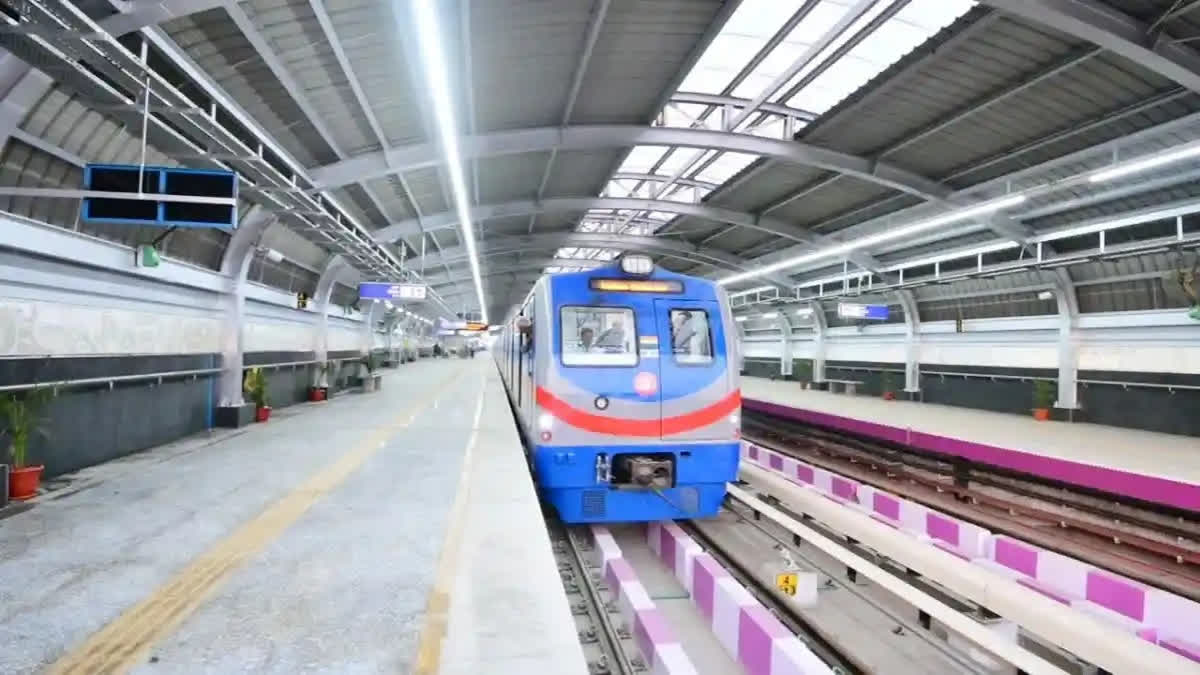Kolkata (West Bengal): The first time a train ran underground in the country was on October 24, 1984, and India got figured on the Metro Railway communication map of the world with Kolkata Metro as its first connection.
In a brief span, the underground transport system turned into a lifeline for the metropolis. Come March 6, a new feather is waiting to get added to Metro's network in the city. As part of the East-West Metro corridor, the country's first underwater Metro train will run between Howrah and Esplanade, where passengers will be welcomed with a blue light sweeping the tunnels, till the trains cross the Hooghly River.
Blast from the past: According to records available with the Metro authorities, it was the Britishers who first mooted the idea of connecting Howrah with Kolkata via a tube railway service way back in 1921. But, that plan was eventually shelved. It was only in 1969 that the Metropolitan Transport Project was conceptualised and after much deliberation, five separate routes were decided as Kolkata's Metro network.
Among the four, the first route was the North-South Corridor, which today stretches from Dakshineswar in the north to New Garia in the south, a total distance of nearly 33 kms. The East-West Metro corridor was given a go-ahead by the United Progressive Alliance (UPA) government at the Centre in 2008 and the foundation stone was laid in 2009.
East-West Metro Corridor: The new route of this corridor was designed to stretch between Salt Lake Sector V and Howrah Maidan, an estimated distance of 16.55 kms. This was the first concrete effort to join Kolkata and Howrah, across River Hooghly. This new corridor, like its older sibling, is a mix of underground as well as overground/elevated stations.
The first phase of this route is already in service from Salt Lake Sector V to Sealdah, with Sealdah Railway Station being one of the busiest terminal train stations in the country. State-of-the-art, fail-safe technology with a Communication-Based Train Control signalling system along with screen doors have been installed along this route to ensure enhanced safety for passengers.
Howrah Metro Station: The deepest station of the East-West Kolkata Metro corridor is Howrah metro station. This station is nearly the height of a 10-storey building. This is the deepest metro station in India. The Indian Railway system will operate its suburban and long-distance service on the ground and metro trains will be running underground. The Howrah metro rail station has five levels, with four concourses and platforms.
The underwater stretch: The tunnel system through which trains will run under the River Hooghly is known as subaqueous tunnels. Two parallel tunnels were dug with the help of tunnel boring machines, balancing the earth's pressure with that of the water mass. The length of the tunnel is 520 metres and trains can run up to a speed of 80 kms per hour. According to initial railway estimates, the passenger density during peak hours will be around 30,000 commuters and the average travel time underwater will be 45 seconds.
When the Red Lights Glows: Emergency situations and evacuation processes have been on the minds of the designers and planners when the underwater stretch was being conceptualised. Though this particular section was constructed within 66 days, there are walkways on all sides of both tunnels, which are connected to ventilation shafts. During any emergency, passengers can be evacuated through these shafts, using the walkways. There are eight cross-passages inside the tunnel that are interlinked with the tunnels for easy and smooth evacuation.
East-West Metro connection has always been the much-awaited Metro link of Kolkata. Not only does it provide that unique experience of travelling underwater in a Metro train, but the route connects both Sealdah and Howrah railway terminal stations, two of the busiest stations in the country in terms of the number of commuter footfalls.
Adding to that, the route also traverses the central business district of Kolkata, the Esplanade and BBD Bag areas and links them directly with the technology hub in Salt Lake Sector V. With the Metro authorities hoping to get around seven lakh passengers on a daily basis, the East-West Metro railway stretch is poised to be one of the busiest Metro rail connections in the country.
Prime Minister Narendra Modi will inaugurate the Underground Metro in Kolkata on March 6.



